 India has emerged as the world’s third-largest publisher of science and engineering articles, according to a latest US report. In 2008, India published 48,998 science and engineering articles. This increased to 1,35,788 articles in 2018 and the country now accounts for 5.31 per cent of the total world publications in science and engineering. China, which accounts for 20.67 per cent of all global publications in scientific articles, is at the top position, followed by the US at 16.54 per cent, as per the statistics compiled by the US National Science Foundation (NSF). India has emerged as the world’s third-largest publisher of science and engineering articles, according to a latest US report. In 2008, India published 48,998 science and engineering articles. This increased to 1,35,788 articles in 2018 and the country now accounts for 5.31 per cent of the total world publications in science and engineering. China, which accounts for 20.67 per cent of all global publications in scientific articles, is at the top position, followed by the US at 16.54 per cent, as per the statistics compiled by the US National Science Foundation (NSF). |
| Source: The NDTV |
 The Quality Council of India (QCI) recently released its survey on imported toys. According to the report, 66.9% of the toys failed the test. The Quality Council of India (QCI) recently released its survey on imported toys. According to the report, 66.9% of the toys failed the test. |
| Highlights The QCI conducted the testing on toys that were available in the Delhi markets and in the National Capital Region. Around 121 varieties were procured and submitted to NABL (National Accreditation Board for Testing and calibration Laboratories). Of the tested varieties, 30% of the plastic toys failed to meet the tests of permissible level of phthalate, heavy metals, etc. Around 80% of the toys failed to meet the physical and mechanical safety properties. In the soft toys, 45% failed on phthalate test and 75% failed on tests conducted on mechanical properties. Of the toys sold in Delhi markets, 85% are from China, followed by Sri Lanka, Malaysia and Germany. |
| Quality Council of India The QCI was set up in 1997 to establish and promote quality standards across social and economic sectors. The services offered by QCI include quality assessment, accreditation services, quality promotion, etc. It is associated with CII (Confederation of India Industry), ASSOCHAM (where PM Modi addressed its 100th year celebrations). The Council is governed by 38-members. The chairperson of the council is appointed by the PM of India. It functions through 5 main accreditation boards namely NABCB (National Accreditation Board for Certification Bodies), NABET (National Accreditation Board for Education and Training), NBQP (National Board for Quality Promotion), NABH (National Accreditation Board for Hospitals and Healthcare Providers) and NABL. |
 The World Health Organization on December 19, 2019, released its report on Global Tobacco use trends. According to the report, number of males using tobacco has declined globally for the first time. The report says that the anti-smoking campaigns all over the world is the main reason for the number of tobacco users to reduce. The World Health Organization on December 19, 2019, released its report on Global Tobacco use trends. According to the report, number of males using tobacco has declined globally for the first time. The report says that the anti-smoking campaigns all over the world is the main reason for the number of tobacco users to reduce. |
| Highlights: World Globally the number of tobacco users have declined by 60 million people. In 2000, the overall tobacco users were 1.397 billion and it has come down to 1.337 billion in 2018. The report says despite the reduction in numbers, the global target set by governments to reduce the use of tobacco by 30% by 2025 remains off track. So far only 32 countries are on track to reach the target. Around 43 million children (of age 13-15) are using tobacco in 2018. The number of women using tobacco was 244 million. Of all the regions of the world, South East Asian region has the highest use of tobacco. The only region on track to achieve the target is the Americas. |
| Highlights: India According to the report, India is off track to achieve the target of 30% reduction by 2025 as compared to 2010 level. Along with India 163 countries are off the track. However, the consumption rate in India is going down by 21.6% as compared to 2010. The current users of smokeless form of tobacco in India is estimated to be 257,020,000. |
 HDFC Bank has become the 3rd Indian firm to cross $100 billion mark in market capitalisation. HDFC Bank has joined the league of Reliance Industries Ltd, which has a market cap of $140.74 billion, and Tata Consultancy Services (TCS) that has a market cap of $114.60 billion. With this achievement, HDFC Bank is now ranked 110th in the list of world’s most valued companies. Among the world’s most valued banks and financial companies which have a market cap of over $100 billion, HDFC Bank is ranked at 26th position. HDFC Bank has become the 3rd Indian firm to cross $100 billion mark in market capitalisation. HDFC Bank has joined the league of Reliance Industries Ltd, which has a market cap of $140.74 billion, and Tata Consultancy Services (TCS) that has a market cap of $114.60 billion. With this achievement, HDFC Bank is now ranked 110th in the list of world’s most valued companies. Among the world’s most valued banks and financial companies which have a market cap of over $100 billion, HDFC Bank is ranked at 26th position. |
| Source: The Live Mint |
 India, for the first time, ranks among the top 10 in this year’s Climate Change Performance Index (CCPI) at the COP25 climate summit in the Spanish capital Madrid. The current levels of per capita emissions and energy use in India ranked 9th in the high category showing that emissions are still comparatively low. However, despite a high rating for its Climate Policy performance, experts point out that India has yet to develop a roadmap to phase-out fossil fuel subsidies and reduce the country’s high dependence on coal. India, for the first time, ranks among the top 10 in this year’s Climate Change Performance Index (CCPI) at the COP25 climate summit in the Spanish capital Madrid. The current levels of per capita emissions and energy use in India ranked 9th in the high category showing that emissions are still comparatively low. However, despite a high rating for its Climate Policy performance, experts point out that India has yet to develop a roadmap to phase-out fossil fuel subsidies and reduce the country’s high dependence on coal. |
| The authors of the report noted that while the country receives an overall medium rating in the renewable energy category, India’s 2030 renewable energy target is rated very high for its well-below 2 degrees Celsius compatibility. They noted that as none of the countries assessed is already on a path compatible with the Paris climate targets, the first three places of the ranking remain unoccupied. While some EU countries such as Sweden (4th) and Denmark (5th), one of the best climbers, achieve overall high or very high ratings, the performance of EU countries varies largely. While only two G20 countries, the UK (7th) and India (9th), are ranked in the high category, eight G20 countries are remaining in the worst category of the index. Australia (56th out of 61), Saudi Arabia and above all the US perform particularly poor. The index is jointly presented by Germanwatch, NewClimate Institute and Climate Action Network. China, the largest global emitter slightly improves its ranking in the index to 30th place. |
| Source: The News on AIR |
 The United Nations Development Programme released the Human Development Index for 189 countries on December 9, 2019. The rankings were listed by the report titled “Beyond Income, Beyond Averages, Beyond Today: Inequalities in Human Development in 21st century”. India ranked 129 among them, which is one rank ahead of its previous positions. In 2018, India ranked 130. The rankings were listed based on the assessment of poverty, education, life expectancy and access to health care. The United Nations Development Programme released the Human Development Index for 189 countries on December 9, 2019. The rankings were listed by the report titled “Beyond Income, Beyond Averages, Beyond Today: Inequalities in Human Development in 21st century”. India ranked 129 among them, which is one rank ahead of its previous positions. In 2018, India ranked 130. The rankings were listed based on the assessment of poverty, education, life expectancy and access to health care. |
|
 Worldwide arms sales rose by nearly 5 per cent in 2018. According to a new report by the Stockholm International Peace Research Institute (SIPRI), the market is dominated by the United States. The turnover of the 100 biggest arms manufacturers came to 420 billion dollars. US manufacturers alone accounted for 59 per cent of the market, or a turnover of 246 billion dollars, up 7.2 per cent on the previous year. Russia was second in the rankings for arms production, with 8.6 per cent of the market, just ahead of the United Kingdom on 8.4 per cent and France on 5.5 per cent. The study did not include China, for lack of sufficient data. The world’s largest arms maker remains the US firm Lockheed Martin, as it has been since 2009. Its turnover last year was 47.3 billion dollars. Its sales alone account for 11 per cent of the world market. Worldwide arms sales rose by nearly 5 per cent in 2018. According to a new report by the Stockholm International Peace Research Institute (SIPRI), the market is dominated by the United States. The turnover of the 100 biggest arms manufacturers came to 420 billion dollars. US manufacturers alone accounted for 59 per cent of the market, or a turnover of 246 billion dollars, up 7.2 per cent on the previous year. Russia was second in the rankings for arms production, with 8.6 per cent of the market, just ahead of the United Kingdom on 8.4 per cent and France on 5.5 per cent. The study did not include China, for lack of sufficient data. The world’s largest arms maker remains the US firm Lockheed Martin, as it has been since 2009. Its turnover last year was 47.3 billion dollars. Its sales alone account for 11 per cent of the world market. |
| Source: The News on AIR |
 Aberdeen Police station in the Andaman and Nicobar Islands ranks 1st in the list of the best-performing police stations in the country while dealing with a property offence, a crime against women and weaker sections. Home Ministry released the list of ten best-performing Police stations in the country. Balasinor police station in Gujarat secured the 2nd rank while and Ajk Burhanpur in Madhya Pradesh got the 3rd position. The ranking of police stations came after Prime Minister Narendra Modi while addressing the DGPs conference in 2015 in Kutch of Gujarat, had directed that parameters should be laid down for grading police stations and assessing their performance based on feedback. The ranking of top ten Police Stations out of over 15 thousand 500 Police Stations in the country was done through data analysis, direct observation and public feedback. Aberdeen Police station in the Andaman and Nicobar Islands ranks 1st in the list of the best-performing police stations in the country while dealing with a property offence, a crime against women and weaker sections. Home Ministry released the list of ten best-performing Police stations in the country. Balasinor police station in Gujarat secured the 2nd rank while and Ajk Burhanpur in Madhya Pradesh got the 3rd position. The ranking of police stations came after Prime Minister Narendra Modi while addressing the DGPs conference in 2015 in Kutch of Gujarat, had directed that parameters should be laid down for grading police stations and assessing their performance based on feedback. The ranking of top ten Police Stations out of over 15 thousand 500 Police Stations in the country was done through data analysis, direct observation and public feedback. |
| Source: The News on AIR |
 The Comptroller and Auditor General’s report stated that the railways recorded an operating ratio of 98.44% in 2017-18. The above operating ratio was the worst in the last 10 years. Operating ratio is a measure of expenditure against the revenue. It shows the operating efficiency of the railway and the health of its finances. An operating ratio of 98.44% shows that the Railways spent Rs 98.44 to earn Rs 100. The Comptroller and Auditor General’s report stated that the railways recorded an operating ratio of 98.44% in 2017-18. The above operating ratio was the worst in the last 10 years. Operating ratio is a measure of expenditure against the revenue. It shows the operating efficiency of the railway and the health of its finances. An operating ratio of 98.44% shows that the Railways spent Rs 98.44 to earn Rs 100. |
| Source: The Hindu |
 The first-ever Prosperity & Inclusion City Seal and Awards (PICSA) Index, released in the Basque Country capital of Bilbao in northern Spain. The Index is designed to showcase not only the quantity of economic growth of a city but also its quality and distribution across populations. Bengaluru emerged as India’s highest-ranked city at No. 83 in a new index of the world’s 113 cities in terms of economic and social inclusivity, topped by Zurich in Switzerland. Delhi at 101 and Mumbai at 107 are the other Indian cities to make at the index, with the top 20 awarded a PICSA Seal as the world’s highest-ranked cities building inclusive prosperity. Vienna, the Austrian capital in second place, scores close to top marks on healthcare. Copenhagen, Luxembourg and Helsinki complete the top five. The first-ever Prosperity & Inclusion City Seal and Awards (PICSA) Index, released in the Basque Country capital of Bilbao in northern Spain. The Index is designed to showcase not only the quantity of economic growth of a city but also its quality and distribution across populations. Bengaluru emerged as India’s highest-ranked city at No. 83 in a new index of the world’s 113 cities in terms of economic and social inclusivity, topped by Zurich in Switzerland. Delhi at 101 and Mumbai at 107 are the other Indian cities to make at the index, with the top 20 awarded a PICSA Seal as the world’s highest-ranked cities building inclusive prosperity. Vienna, the Austrian capital in second place, scores close to top marks on healthcare. Copenhagen, Luxembourg and Helsinki complete the top five. |
| Source: The DD News |
You need to login to perform this action.
You will be redirected in
3 sec
